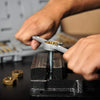
How to Use a Magnetic Tool Holder for DIY Tool Organization
Introduction
A magnetic tool holder is an incredibly versatile and useful addition to any DIY workspace. With the ability to securely hold tools of varying shapes and sizes, it can help you maintain an organized and efficient work area.
This article will delve into the benefits of magnetic tool holders, provide a comprehensive guide to choosing and installing the right one for your needs, and offer expert tips on maximizing its utility.
Whether you're a novice DIY enthusiast or a seasoned professional, this in-depth exploration will equip you with the knowledge needed to optimize your tool organization using a magnetic holder.
Table of Contents
- The Benefits of Using a Magnetic Tool Holder
- Selecting the Right Magnetic Tool Holder
- Types of Magnetic Tool Holders
- Factors to Consider When Choosing a Holder
- Installing Your Magnetic Tool Holder
- Proper Placement
- Securing the Holder
- Organizing Your Tools on the Magnetic Holder
- Grouping Similar Tools
- Arranging Tools by Frequency of Use
- Balancing Weight Distribution
- Tips and Tricks for Maximizing Tool Holder Efficiency
- Safety Precautions When Using a Magnetic Tool Holder
- Conclusion
The Benefits of Using a Magnetic Tool Holder
Magnetic tool holders offer numerous advantages for DIY enthusiasts, including:
- Space-saving: By attaching tools to a wall-mounted magnetic strip, you can free up valuable workspace and reduce clutter.
- Easy access: Magnetic holders allow you to quickly grab and return tools without rummaging through drawers or toolboxes.
- Increased efficiency: Having all your tools visible and within reach can help streamline your workflow and minimize interruptions.
- Damage prevention: Hanging tools on a magnetic holder can prevent them from being dropped or knocked over, reducing the risk of damage.
- Versatility: Magnetic holders can accommodate a wide range of tools, from small screwdrivers to large wrenches, making them suitable for various DIY tasks.
Selecting the Right Magnetic Tool Holder
Types of Magnetic Tool Holders
There are several types of magnetic tool holders available, including:
- Magnetic strips: These long, narrow strips can be mounted on walls or workbenches and are designed to hold multiple tools. They're available in various lengths and strengths.
- Magnetic bars: These are similar to strips but have a more robust construction and can handle heavier tools. They may also feature hooks or other attachments for added versatility.
- Magnetic trays: These shallow, flat containers have a magnetic base that can securely hold small metal objects, such as screws and nails. They can be placed on work surfaces or attached to a magnetic strip or bar.
- Magnetic pegboards: These are wall-mounted panels with a magnetic surface that can hold a variety of tools and accessories. They often include adjustable hooks, shelves, and other attachments for custom organization.
Factors to Consider When Choosing a Holder
Before purchasing a magnetic tool holder, consider the following factors:
- Tool size and weight: Ensure the holder can accommodate the dimensions and weight of your tools. Check the manufacturer's specifications for weight limits and compatibility.
- Available space: Measure the area where you plan to install the holder and choose one that fits comfortably within the space.
- Materials: Consider the materials used in the construction of the holder, as this will affect its durability, appearance, and ability to resist corrosion. Common materials include stainless steel, aluminum, and plastic.
- Strength and durability: Opt for a holder made from high-quality materials with a strong magnet to ensure it can securely hold your tools.
- Ease of installation: Look for a holder that comes with clear instructions and all necessary hardware for a hassle-free setup.
-
Price: Magnetic tool holders vary in price, so set a budget and compare options within your price range to find the best value.
Installing Your Magnetic Tool Holder
Proper Placement
Selecting the right location for your magnetic tool holder is crucial. Consider these factors when choosing a spot:
- Accessibility: Place the holder within easy reach so you can quickly grab and return tools while working.
- Visibility: Ensure the holder is positioned in a well-lit area where you can easily see all your tools.
- Workspace layout: Install the holder in a location that won't interfere with your workspace or impede your movement.
Securing the Holder
Follow these steps to install your magnetic tool holder:
- Mark the desired location on the wall or workbench, ensuring it's level and at an appropriate height.
- Drill pilot holes (if necessary) for screwspirits or other mounting hardware.
- Attach the holder using the provided hardware, making sure it's securely fastened and flush against the surface.
-
Test the strength of the magnet by placing a few tools on the holder to ensure they stay in place.
Organizing Your Tools on the Magnetic Holder
To get the most out of your magnetic tool holder, follow these organization tips:
Grouping Similar Tools
Arrange your tools by type or function to make it easier to locate specific items. For example, group screwdrivers together, separate from pliers and wrenches.
Arranging Tools by Frequency of Use
Position frequently used tools in the most accessible spots on the holder, while less frequently used items can be placed towards the edges.
Balancing Weight Distribution
Evenly distribute the weight of your tools across the holder to prevent it from sagging or becoming unbalanced. Place heavier tools near the center and lighter ones towards the ends.
Tips and Tricks for Maximizing Tool Holder Efficiency
Here are some expert suggestions for optimizing your magnetic tool holder:
- Label sections: Use labels or markers to designate areas on the holder for specific tools or categories.
- Add accessories: Attach hooks, clips, or shelves to the holder to store non-magnetic items, such as tape measures and safety glasses.
- Create a tool inventory: Keep track of your tools by creating a list or diagram of their locations on the holder. This can help you quickly locate items and ensure everything is returned to its proper spot after use.
Safety Precautions When Using a Magnetic Tool Holder
While magnetic tool holders are generally safe and easy to use, it's essential to observe these safety guidelines:
- Avoid overloading: Do not exceed the weight limit specified by the manufacturer, as this can cause the holder to fail and potentially damage your tools or cause injury.
- Keep magnets away from electronics: Magnets can interfere with or damage electronic devices, so maintain a safe distance between your holder and any sensitive equipment.
- Be mindful of sharp edges: Exercise caution when handling tools with sharp edges or points to prevent cuts or puncture wounds.
- Secure loose parts: Ensure all mounting hardware is tightly fastened and regularly inspect the holder for signs of wear or damage.
Conclusion
A magnetic tool holder is an invaluable asset for any DIY workspace, offering numerous benefits such as space-saving, easy access, and increased efficiency. By selecting the right type of holder, installing it properly, and organizing your tools effectively, you can significantly enhance your DIY experience.
Additionally, following expert tips and observing safety precautions will ensure you get the most out of your magnetic tool holder while minimizing potential risks.
In conclusion, investing in a magnetic tool holder is a smart choice for DIY enthusiasts and professionals alike, providing an organized and efficient solution for tool storage and management.



